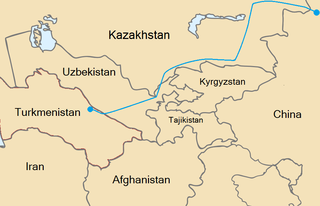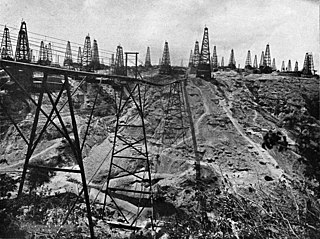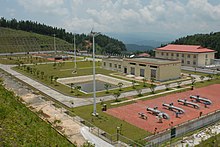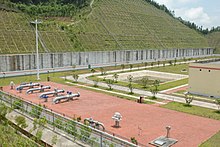
PetroChina Company Limited is a Chinese oil and gas company and is the listed arm of state-owned China National Petroleum Corporation (CNPC), headquartered in Dongcheng District, Beijing. The company is currently Asia's largest oil and gas producer and was China's second biggest oil producer in 2006. Traded in Hong Kong and New York, the mainland enterprise announced its plans to issue stock in Shanghai in November 2007, and subsequently entered the constituent of SSE 50 Index. In the 2020 Forbes Global 2000, PetroChina was ranked as the 32nd-largest public company in the world.

China Petroleum & Chemical Corporation (中国石油化工股份有限公司) or Sinopec, is a Chinese oil and gas enterprise based in Beijing. It is listed in Hong Kong and also trades in Shanghai and New York.

The China National Petroleum Corporation (CNPC) is a major national oil and gas corporation of China and one of the largest integrated energy groups in the world. Its headquarters are in Dongcheng District, Beijing. CNPC was ranked fourth in 2020 Fortune Global 500, a global ranking of the largest corporations by revenue.
Kyaukpyu is a major town in Rakhine State, in western Myanmar. It is located on the north western corner of Yanbye Island on Combermere Bay, and is 250 miles (400 km) north-west of Yangon. It is the principal town of Kyaukpyu Township and Kyaukpyu District. The town is situated on a superb natural harbor which connects the rice trade between Calcutta and Yangon. The estimated population in 1983 was 19,456 inhabitants. The population of Kyaukpyu Urban area is 20,866 as of 2014, while Kyaukpyu Township's population is 165,352.

The Central Asia–China gas pipeline is a natural gas pipeline system from Central Asia to Xinjiang in the People's Republic of China. By connecting Turkmenistan to China’s domestic grid, this pipeline makes it possible to transport gas some 7000 km from Turkmenistan to Shanghai. More than half of Turkmen natural gas exports are delivered to China through the pipeline.
The West–East Gas Pipeline is a set of natural gas pipelines which run from the western part of China to the east.
The Shaan–Jing pipeline is a natural gas pipeline in China, which runs from Jingbian County to Beijing and Tianjin.
The Eastern Siberia–Pacific Ocean oil pipeline is a pipeline system for exporting Russian crude oil to the Asia-Pacific markets. The pipeline is built and operated by Russian pipeline company Transneft.
The Altai gas pipeline is a proposed natural gas pipeline to export natural gas from Russia's Western Siberia to North-Western China.
The national holding company Uzbekneftegaz is a state-owned holding company of Uzbekistan's oil and gas industry.

Kyaukpyu Township is a township of Kyaukpyu District in the Rakhine State of Myanmar. The principal town is Kyaukpyu.

Muse is the capital town of Mu Se Township in northern Shan State, Myanmar. It is situated on the Shweli River, and is connected by a bridge and road to Ruili in Yunnan Province, China.
The China Petroleum Engineering and Construction Corporation is a construction engineering company that builds refineries, pipelines, and other oil and gas related infrastructure. It is a subsidiary of the China National Petroleum Corporation.
Bagtyýarlyk is a large contractual PSA territory consisting of several natural gas fields located in Lebap Province of Turkmenistan. It literally means happiness in Turkmen language. Bagtyyarlyk constitutes the bigger part of the gas rich Sagkenar area and includes Saman- Depe and Altyn Asyr fields.

Iran is an energy superpower and the petroleum industry in Iran plays an important part in it. In 2004, Iran produced 5.1 percent of the world's total crude oil, which generated revenues of US$25 billion to US$30 billion and was the country's primary source of foreign currency. At 2006 levels of production, oil proceeds represented about 18.7% of gross domestic product (GDP). However, the importance of the hydrocarbon sector to Iran's economy has been far greater. The oil and gas industry has been the engine of economic growth, directly affecting public development projects, the government's annual budget, and most foreign exchange sources.

China National Offshore Oil Corporation, or CNOOC Group, is one of the largest national oil companies in China, and the third-largest national oil company in China, after CNPC and China Petrochemical Corporation. The CNOOC Group focuses on the exploitation, exploration and development of crude oil and natural gas in offshore China, along with its subsidiary COOEC.

China–Russia relations, also known as Sino-Russian relations, refers to international relations between the People's Republic of China and the Russian Federation. Diplomatic relations between China and Russia improved after the dissolution of the Soviet Union and establishment of the Russian Federation in 1991. American scholar Joseph Nye states:
With the collapse of the Soviet Union, that de facto US-China alliance ended, and a China–Russia rapprochement began. In 1992, the two countries declared that they were pursuing a "constructive partnership"; in 1996, they progressed toward a "strategic partnership"; and in 2001, they signed a treaty of "friendship and cooperation."

Myanmar, is a developing country and an important natural gas and petroleum producer in Asia. It is home to one of the world's oldest petroleum industries, with its first crude oil exports dating back to 1853. Today, the country is one of the major natural gas producers in the Asian continent. Decades of isolation, sanctions, a lack of technical capacity, opaque government policies and insufficient investment has impeded the country's efforts to develop an upstream hydrocarbon sector. Recent but slow political reform has led the international community to ease sanctions on Burma, giving rise to hopes of greater investment and economic growth. In 2015-2016, the petroleum industry attracted the highest-ever amount of foreign direct investment (FDI) in the history of Myanmar.
Kyaukphyu Special Economic Zone is a 1,600 hectares Burmese special economic zone being developed on Kyaukphyu, Ramree Island, Rakhine State. Kyaukphyu SEZ was first announced in September 2013. The project initially began as a joint venture between the Chinese and Burmese governments, but has since transitioned to private developers. Kyaukphyu SEZ will be accessible to the Shwe gas field in the Bay of Bengal. The oil and gas terminal was financed by the China National Petroleum Corporation which built two pipelines for natural gas and oil.
The China Petroleum Pipeline Engineering Co., Ltd. (CPP) is a subsidiary of the China National Petroleum Corporation and the primary builder of pipelines in China. The company has built much of the cross-country pipeline infrastructure in China and had several large-scale projects abroad.










